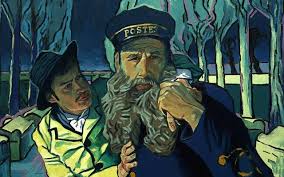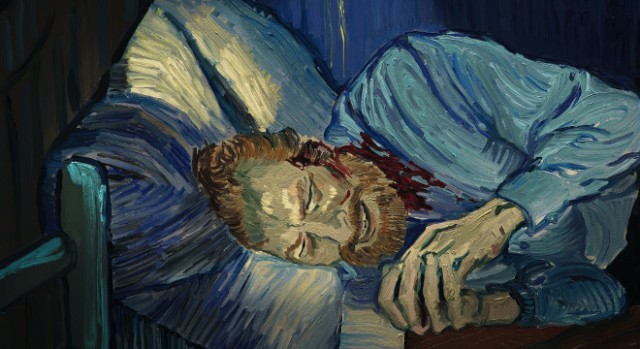
The conceit or gimmick behind “Loving Vincent,” a new Anglo-Polish film about the last days of Vincent Van Gogh, was to cast it and film it with live actors on real sets, and then paint-over those images in the Van Gogh style.
Flashbacks are often charcoaled-over sketches, and the rest of the film is in those twisting, loaded brush strokes of the Impressionist master — heavy raindrops, lurid yellow sunflowers drooping from the weight of the paint, windmill sails blurring in the liquid breeze, vivid blue backdrops to those starry, starry nights.
The characters are the many people Van Gogh painted, the settings familiar to anyone even passingly acquainted with his paintings.
The story is far more conventional, a “Citizen Kane/Rashomon” series of remembrances of the man — “mad…loving…interesting…normal…genius” — often conflicting and all part of a “Kane” styled “investigation.” It makes for a fine primer on Van Gogh’s last days, the heros, heroines and villains in his life, though nothing shown here amounts to a new “revelation” about how and why he died.
Armand (Douglas Booth) is sent in search of Van Gogh’s surviving family a year after his death, a quest he’s given by his father (Chris O’Dowd, painted into a beard). The old man was Van Gogh’s postman for a time, and his friend. He’s dismissive of his son’s glib characterization of the “crazy” man who once cut off an ear, and finally killed himself with a revolver.
“Live longer. You’re see life can bring down even the strong.”
There’s one last undelivered letter from Vincent to his art dealer brother, Theo, siblings who were “two hearts, one mind.” Armand must deliver that letter.
But it’s a year after Vincent’s death, and in those pre-Internet, pre-newspaper obituary days (1891), Armand doesn’t know Theo is dead. So he seeks the last folks to know Vincent, the doctor who treated him, the inn where Vincent died in Auvers-sur-Oise. And that’s where the mystery deepens.
The story, built from letters and other Van Gogh history, sends Armand, in his yellow suit and omnipresent black hat, to this character or that one — people Van Gogh painted, actors dressed and made up as he painted them.
“He went everywhere. He liked the river. Ask the boatman.”
There’s a charming innkeeper’s daughter (Eleanor Tomlinson) to interview, and the doctor’s disapproving housekeeper (Helen McCrory) and his daughter (Saoirse Ronan) whom Vincent may have had a crush on.

Neither Armand nor we get definitive answers about Vincent’s troubles, his sudden decision to shoot himself, the lack of treatment from his “friend” and supporter, Dr. Gachet, a man who took Vincent’s best paintings as “payment” for the dead man’s bill.
It would all make for a passable movie — perhaps made for TV or Netflix — without painting over the performances. But the animation lifts “Loving Vincent” (he signed some of his letters with a hearty “handshake from your loving Vincent”) above the mystery, above mere biography, into something brilliant, revealing and unique.
What other animated film has hair-styling and costumer credits?

MPAA Rating: PG-13 for mature thematic elements, some violence, sexual material and smoking
Cast: Douglas Booth, Saoirse Ronan, Chris O’Dowd, Helen McCrory, Eleanor Tomlinson
Credits:Written and directed by Dorota Kobiela, Hugh Welchman. A Good Deed/Silver Reel release.
Running time: 1:34
